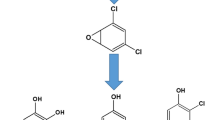Summary
The study validated the use of urinary toluene diamine (TDA) in postshift samples as an indicator of preceding 8-h exposure to toluene diisocyanate (TDI). Nine workers exposed in TDI-based polyurethane foam production were studied. Their exposure levels varied in 8-h time-averaged samples from 9.5 to 94 μg/m3. The urinary TDA concentrations varied from 6.5 to 31.7μg/g creatinine and they were linearly related to the atmospheric TDI levels. Approximately 20% of TDI is metabolized to diamines but their specificity is remarkable to the extent that by analysis for the 2,4- and 2,6-diamino isomers an idea of the percutaneous absorption may be had.
Similar content being viewed by others
References
Bagon DA, Warwick CJ, Brown RH (1984) Evaluation of total isocyanate-in-air method using 1-(2-methoxyphenyl) piperazine and HPLC. Am Ind Hyg Assoc J 45:39–43
Berode M, Testa B, Savolainen H (1991) Bicarbonate-catalyzed hydrolysis of hexamethylene diisocyanate to 1,6-diaminohexane. Toxicol Lett 56:173–178
Holness DL, Broder I, Corey PN, Booth N, Mozzon D, Guirguis S, Nazar MA (1984) Respiratory variables and exposure effect relationships in isocyanate-exposed workers. J Occup Med 26:449–455
Lesage J, Goyer N, Desjardins F, Vincent JY, Perrault G (1992) Workers' exposure to isocyanates. Am Ind Hyg Assoc J 53:146–153
Musk AW, Peters JM, D-Berardinis L, Murphy RL (1982) Absence of respiratory effects in subjects exposed to low concentrations of TDI and MDI. J Occup Med 24:746–750
Rando RJ, Abdel-Kader HM, Hammad YY (1984) Isometric composition of airborne TDI in the polyurethane foam industry. Am Ind Hyg Assoc J 45:199–203
Rosenberg C, Savolainen H (1986) Determination of occupational exposure to toluene diisocyanate by biological monitoring. J Chromatogr 367:385–392
Skarping G, Brorson T, Sangö C (1991) Biological monitoring of isocyanates and related amines. III. Test chamber exposure of humans to toluene diisocyanate (TDI). Int Arch Occup Environ Health 63:83–88
Brorson T, Skarping G, Sangö C (1991) Biological monitoring of isocyanates and related amines. IV. 2,4- and 2,6-toluenediamine in hydrolysed plasma and urine after test-chamber exposure of humans to 2,4- and 2,6-toluene diisocyanate. Int Arch Occup Environ Health 63:253–259
Wegman DH, Musk AW, Main DM, Pagnotto LD (1982) Accelerated loss of FEVI in polyurethane production workers: a four-year prospective study. Am J Ind Med 3:209–215
Zender R, Falbriand A (1965) Analyse automatique de la créatinine dans le sérum et dans l'urine. Clin Chem Acta 12:183–190
Author information
Authors and Affiliations
Rights and permissions
About this article
Cite this article
Maître, A., Berode, M., Perdrix, A. et al. Biological monitoring of occupational exposure to toluene diisocyanate. Int. Arch Occup Environ Heath 65, 97–100 (1993). https://doi.org/10.1007/BF00405726
Received:
Accepted:
Issue Date:
DOI: https://doi.org/10.1007/BF00405726




